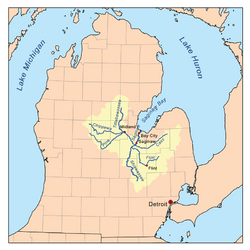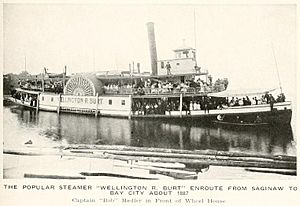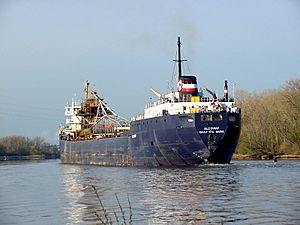Saginaw River facts for kids
Quick facts for kids Saginaw River |
|
|---|---|

Saginaw River watershed
|
|
| Country | United States |
| State | Michigan |
| Counties | Saginaw County, Bay County |
| Cities | Saginaw, Zilwaukee, Bay City, Essexville |
| Physical characteristics | |
| Main source | confluence of Shiawassee River and Tittabawassee River Saginaw 577 ft (176 m) 43°23′14″N 83°57′58″W / 43.387248°N 83.9660845°W |
| River mouth | Saginaw Bay boundary of Bangor and Hampton townships 571 ft (174 m) 43°38′49″N 83°51′02″W / 43.6469667°N 83.8505319°W |
| Length | 22 mi (35 km) |
| Basin features | |
| Basin size | 8,595 sq mi (22,260 km2) |
The Saginaw River is a 22.4-mile (36.0 km) long river in the U.S. state of Michigan. It starts where the Tittabawassee and Shiawassee rivers meet, southwest of Saginaw. The river then flows north into the Saginaw Bay, which is part of Lake Huron. It passes through the cities of Saginaw and Bay City. These cities grew up around the river in the 1800s.
The area of land that drains into the Saginaw River is about 8,595 square miles (22,260 km²). At its end, the river lets out about 4,827 cubic feet (136.7 m³) of water per second. The Saginaw River is an important route for ships in Mid-Michigan. It is one of the few rivers in Michigan that ships can travel on. The Saginaw River Rear Range Light is a lighthouse built in 1876 to help ships navigate. It was added to the National Register of Historic Places in 1984 and is being fixed up.
Contents
River History: A Journey Through Time
For thousands of years, Native American peoples used the Saginaw River. They fished in it and traveled by canoe. When Europeans arrived, the river became a place for fur traders to meet. They traded goods with the Ojibwe tribes living in the area.
As towns grew along the river, it helped people travel further inland. The river also powered sawmills and later factories. The first lighthouse was finished in 1841. Later, two lighthouses were built in 1876 to guide ships. These lighthouses started using electricity in 1915. The Saginaw River Rear Range Light is a historic lighthouse that is being restored.
In the late 1800s, steamboats like the Wellington R. Burt carried people. They traveled between Saginaw and Bay City, and to other ports on the Great Lakes. Today, the Saginaw River is still a major route for trade. It helps move goods into and out of the region. The river carries about 4.6 million tons of goods every year.
Other industries also grew along the river. Companies like General Motors and Dow Chemical Company set up large operations there. These companies created many jobs for people in the area. New industries in the region now include advanced manufacturing, medical technology, and renewable energy.
Fun on the River: Activities for Everyone
Over the years, people have worked to make the Saginaw River a great place for fun. Cities have built special areas for residents to enjoy the river. A three-mile (4.8 km) long RiverWalk was built along the riverbanks in downtown Saginaw and Bay City. It's perfect for walking, biking, or just taking a stroll.
The Saginaw Bay Yacht Club, started in 1894, is near the river's mouth. It hosts regular sailing races and other events. Many people also enjoy boating with motors on the river.
Fishing is very popular here. Many people join the annual "Shiver on the River" walleye ice fishing contest. In winter, people catch large fish by fishing through holes in the ice. There's also another fishing season in early spring.
Hundreds of thousands of people come to the riverbanks for yearly festivals. These include the River Roar speed boat races and Tall Ship Celebrations. The river also hosts two of the biggest fireworks shows in the Midwest. In 2012, Bay City had Michigan's largest fireworks show on the Saginaw River. It had 50,000 fireworks and lasted 50 minutes. This celebrated the 50th anniversary of the Bay City Fireworks Festival.
Keeping the River Clean: Important Projects
The area around the Saginaw Bay and River has the largest freshwater coastal wetland in America. But because of factories and growing towns since the 1800s, the Saginaw River and its surrounding land have been polluted. Different wastes were put into the river and its smaller streams.
Since the 1970s, new laws have been made to control waste. These laws also set up programs to prevent pollution. Historically, companies like Dow Chemical Company and General Motors contributed to pollution. The cities of Bay City and Saginaw also played a part.
In 1994, the government and the Saginaw Chippewa Indian Tribe took legal action against General Motors and the cities of Saginaw and Bay City. They said these groups had put harmful chemicals into the river. In 1998, General Motors and the cities agreed to a $28.22 million agreement. This was one of Michigan's biggest environmental agreements. Work to remove polluted mud from the river began in 1999.
Efforts to clean up the Saginaw River, its branch the Tittabawassee River, and Saginaw Bay are still ongoing. In 2010, the US Environmental Protection Agency and Dow Chemical made an agreement. This agreement helps control pollution and clean up polluted soils in these areas.
See also
 In Spanish: Río Saginaw para niños
In Spanish: Río Saginaw para niños




